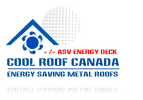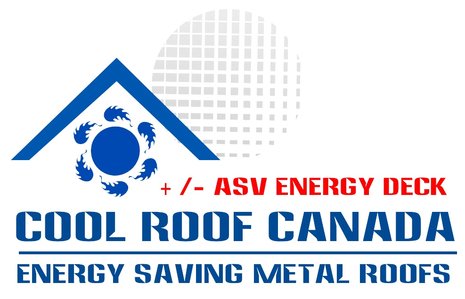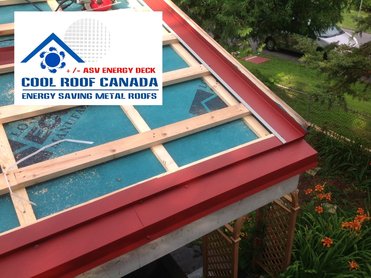An ENERGY SAVER Roof Deck Provides Above Sheathing Ventilation & Energy Savings
A double strapped roof deck is shown below VS a single strapped roof deck which is shown on the right hand side below.
While both both provide ventilation, only a double strapped roof provides both the drainage and ventilation needed to deal with condensation build up behind metal roofing
Condensation builds behind horizontal single strapped systems because there is no drainage and can eventually rot out both the wood strapping and the sheathing deck that holds the metal roof panels in place.
The inherent flaws in this design have given self ventilated metal roofs a reputation of trapping moisture which is totally unwarranted
NEVER LET A CONTRACTOR INSTALL ONLY SINGLE STRAPPING BENEATH YOUR NEW METAL ROOF. EITHER INSTALL 'DIRECT TO DECK' & FORFEIT ENERGY SAVINGS, OR DOUBLE STRAP YOUR ROOF. SINGLE STRAPPING WILL CAUSE MOISTURE BUILDUP AND ROOF FAILURE
While both both provide ventilation, only a double strapped roof provides both the drainage and ventilation needed to deal with condensation build up behind metal roofing
Condensation builds behind horizontal single strapped systems because there is no drainage and can eventually rot out both the wood strapping and the sheathing deck that holds the metal roof panels in place.
The inherent flaws in this design have given self ventilated metal roofs a reputation of trapping moisture which is totally unwarranted
NEVER LET A CONTRACTOR INSTALL ONLY SINGLE STRAPPING BENEATH YOUR NEW METAL ROOF. EITHER INSTALL 'DIRECT TO DECK' & FORFEIT ENERGY SAVINGS, OR DOUBLE STRAP YOUR ROOF. SINGLE STRAPPING WILL CAUSE MOISTURE BUILDUP AND ROOF FAILURE
ASV (Above Sheathing Ventilation)
ASV Studies on the Effects of ASV on Coated Metal Roofs - Oakridge Lab ofStanford University Field Test Results
Miller, Wilson, and Karagiozis (2006) field tested coated metal roofs on adjacent attic test assemblies very similar to the assemblies used for testing tile.
A commercially available asphalt shingle with a solar reflectance of 0.093 and a thermal emittance of 0.89 (SR093E89) was selected as the control for comparing the thermal performance of the metal roof systems. A conventional dark-gray steel metal shake (SR08E90) and a light-gray shake (SR26E90) were tested on identical batten and counter-batten constructions.
All attic assemblies were equipped with 1 ft2 of soffit and ridge ventilation per 300 ft2 of attic footprint for supporting attic ventilation. Miller, Wilson, and Karagiozis (2006) observed that venting the underside of the dark-gray metal shake significantly reduced the heat flow crossing the deck during solar noon.
The dark-gray coated metal shake and the asphalt shingle have almost identical reflectance and emittance characteristics, yet the heat flow crossing the roof deck of the dark-gray shake was just 70% of the heat flow crossing the roof deck of the asphalt control shingle. The 30% reduction in heat flow is due to ASV.
The resulting air cavity also ventilates the roof which Oak Ridge National Laboratory labels as Above Sheathing Ventilation (ASV). ORNL recently stated “we serendipitously discovered the second major advance in roofs for our century: We found that elevating the roof cover from the roof deck to induce above-sheathing ventilation is as important as increasing solar reflectance and may be the stronger player in reducing heat gain into the attic. The two combined can reduce heat gain through the roof by 50% compared to nailed asphalt shingle roofs.”
Miller, Wilson, and Karagiozis (2006) concluded that ventilating the deck is just as important as is increasing solar reflectance and is the stronger player in reducing heat gain into the attic.
- ASV- is an acronym for Above Sheathing Ventilation. Numerous industry studies have proven that ASV vented roofing can dramatically reduce attic temperatures even when dark colored roofing materials are used.
- Above Sheathing Ventilation is typically created by a ‘Batten’ or ‘Batten-Less’ sub-tile airspace formed between roofing tiles and metal roofing panels.
- This airspace is an approved alternative to California’s Title-24 Energy Code that requires a 20% reflective roof covering.
- Installing an air-space across a roof deck meets California’s ‘2008 BUILDING ENERGY Efficiency Standards for Residential and Non-Residential Buildings’, Effective Jan-1, 2010.
- The code allows exceptions to installing the required 20% reflective roof covering by installing a roof that provides either insulation with a thermal resistance of at least 0.85hrft 2-F/Btu (R-0.85), or a least a ¾” inch air-space is added to the roof deck over an attic.
A Radiant ASV Cool Roof complies with Title 24 California Building Standards, Section 152, and NAHB Green Building Standard, Chapter 7, which both state that roofs installed with an appropriate air gap are considered equivalent to the prescriptive definition of a cool roof (i.e cool pigment roofs)- regardless of the roof color and it's associated solar reflectance.
See: California energy commision cec title24-policy letter
ASV Studies on the Effects of ASV on Coated Metal Roofs - Oakridge Lab ofStanford University Field Test Results
Miller, Wilson, and Karagiozis (2006) field tested coated metal roofs on adjacent attic test assemblies very similar to the assemblies used for testing tile.
A commercially available asphalt shingle with a solar reflectance of 0.093 and a thermal emittance of 0.89 (SR093E89) was selected as the control for comparing the thermal performance of the metal roof systems. A conventional dark-gray steel metal shake (SR08E90) and a light-gray shake (SR26E90) were tested on identical batten and counter-batten constructions.
All attic assemblies were equipped with 1 ft2 of soffit and ridge ventilation per 300 ft2 of attic footprint for supporting attic ventilation. Miller, Wilson, and Karagiozis (2006) observed that venting the underside of the dark-gray metal shake significantly reduced the heat flow crossing the deck during solar noon.
The dark-gray coated metal shake and the asphalt shingle have almost identical reflectance and emittance characteristics, yet the heat flow crossing the roof deck of the dark-gray shake was just 70% of the heat flow crossing the roof deck of the asphalt control shingle. The 30% reduction in heat flow is due to ASV.
The resulting air cavity also ventilates the roof which Oak Ridge National Laboratory labels as Above Sheathing Ventilation (ASV). ORNL recently stated “we serendipitously discovered the second major advance in roofs for our century: We found that elevating the roof cover from the roof deck to induce above-sheathing ventilation is as important as increasing solar reflectance and may be the stronger player in reducing heat gain into the attic. The two combined can reduce heat gain through the roof by 50% compared to nailed asphalt shingle roofs.”
Miller, Wilson, and Karagiozis (2006) concluded that ventilating the deck is just as important as is increasing solar reflectance and is the stronger player in reducing heat gain into the attic.
Cool Roofing with ASV Makes Good Economic Sense
|
DO THE SIMPLE MATH - COOL ROOFING MAKES $ENSE If you use air conditioning for 6 months of the year at an Ontario average cost for running a central AC of $150, then... $150 x 6 =$900/year with asphalt shingle roof $100 x 6 = $600/year with Metal ASV roof (33% Saving) SUMMER SAVINGS $300/year x 15 years (Avg Shingle Life) = $4500 PLUS WINTER SAVINGS OF UP TO 10% ON HEATING |
The Science Behind ASV Vented Roofing Systems
Your browser does not support viewing this document. Click here to download the document.
Tradeoffs Between Solar Reflectance and AboveSheathing Ventilation for Metal Roofs
The contents of report below provide credible and compelling evidence of the benefits provided by roof assemblies fitted with above-sheathing ventilation in each of the ASHRAE climate zones. Results can be peer reviewed and the data used to help convince local, provincial and federal code officials to adopt prescriptive requirements for above-sheathing ventilation.
Specifically, the inclusion of an air space ≥ 1.0 in. (0.0254 m) in stone-coated and offset mounted metal roofs should be classified as a cool roof because their annual cooling loads are less than that for a 2008 Title 24 or for the EPA’s Energy Star cool roof. The field data confirms that an open air space above the sheathing is an excellent design strategy for reducing roof heat gains and losses. It improves the durability of the roof assembly because the natural convection ventilation drys the deck of moisture. It also affords the roof protection from wildfires common in wildlife urban environment interfaces. The thermally induced bouyant flow increases as the metal’s temperature increases. Therefore intense heat is not directly conducted through the metal into the roof deck and ignition is delayed if not eliminated from the system.
An ASV vented roof additionally provides WINTER ENERGY savings when solar reflectance is negated by snow loading.
Specifically, the inclusion of an air space ≥ 1.0 in. (0.0254 m) in stone-coated and offset mounted metal roofs should be classified as a cool roof because their annual cooling loads are less than that for a 2008 Title 24 or for the EPA’s Energy Star cool roof. The field data confirms that an open air space above the sheathing is an excellent design strategy for reducing roof heat gains and losses. It improves the durability of the roof assembly because the natural convection ventilation drys the deck of moisture. It also affords the roof protection from wildfires common in wildlife urban environment interfaces. The thermally induced bouyant flow increases as the metal’s temperature increases. Therefore intense heat is not directly conducted through the metal into the roof deck and ignition is delayed if not eliminated from the system.
An ASV vented roof additionally provides WINTER ENERGY savings when solar reflectance is negated by snow loading.
Your browser does not support viewing this document. Click here to download the document.
Another benefit of ASV - keeps OSB roof sheathing decks stable & moisture free.
Why Energy Star Rated Coatings are NOT effective or relevant in Canada
Your browser does not support viewing this document. Click here to download the document.




